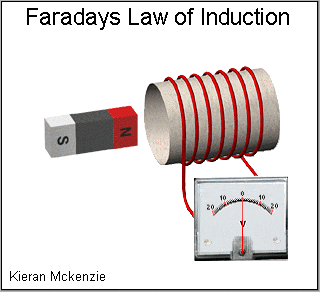Faraday's law of electromagnetic induction states that a changing magnetic field in a closed circuit induces an electromotive force (EMF) and a current in the circuit. This law is named after the English scientist Michael Faraday, who discovered it in 1831.
More specifically, Faraday's law states that the magnitude of the EMF induced in a closed loop is proportional to the rate of change of the magnetic flux through the loop. The magnetic flux is a measure of the amount of magnetic field passing through the loop and is given by the product of the magnetic field strength and the area of the loop perpendicular to the field.
Mathematically, Faraday's law can be expressed as:
EMF = -dΦ/dt
where EMF is the electromotive force induced in the circuit, Φ is the magnetic flux through the circuit, and dΦ/dt is the rate of change of magnetic flux over time.
Faraday's law has numerous applications in the field of electrical engineering, including the generation of electric power in generators, the operation of transformers, and the induction of eddy currents in conductive materials.
